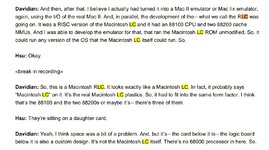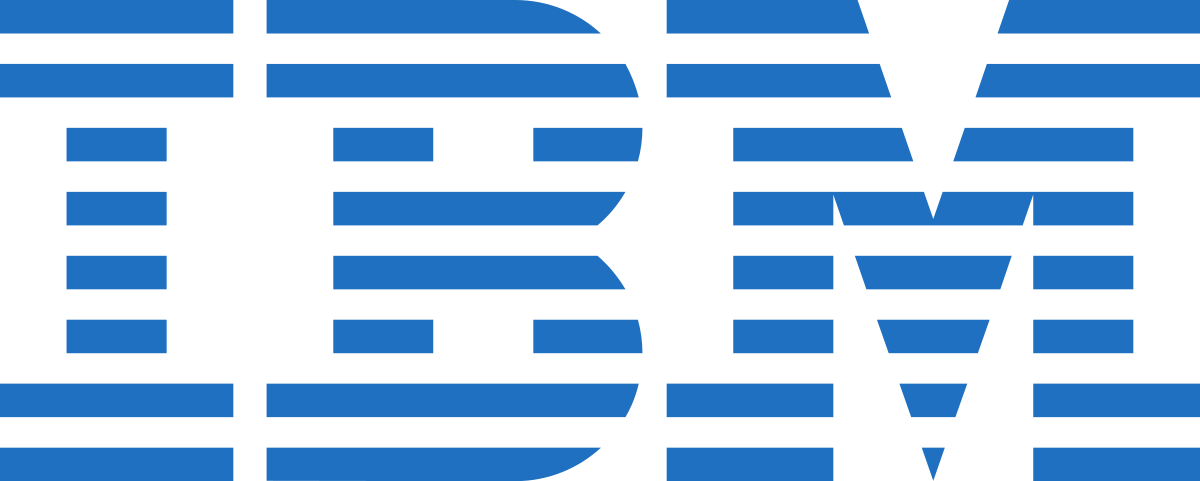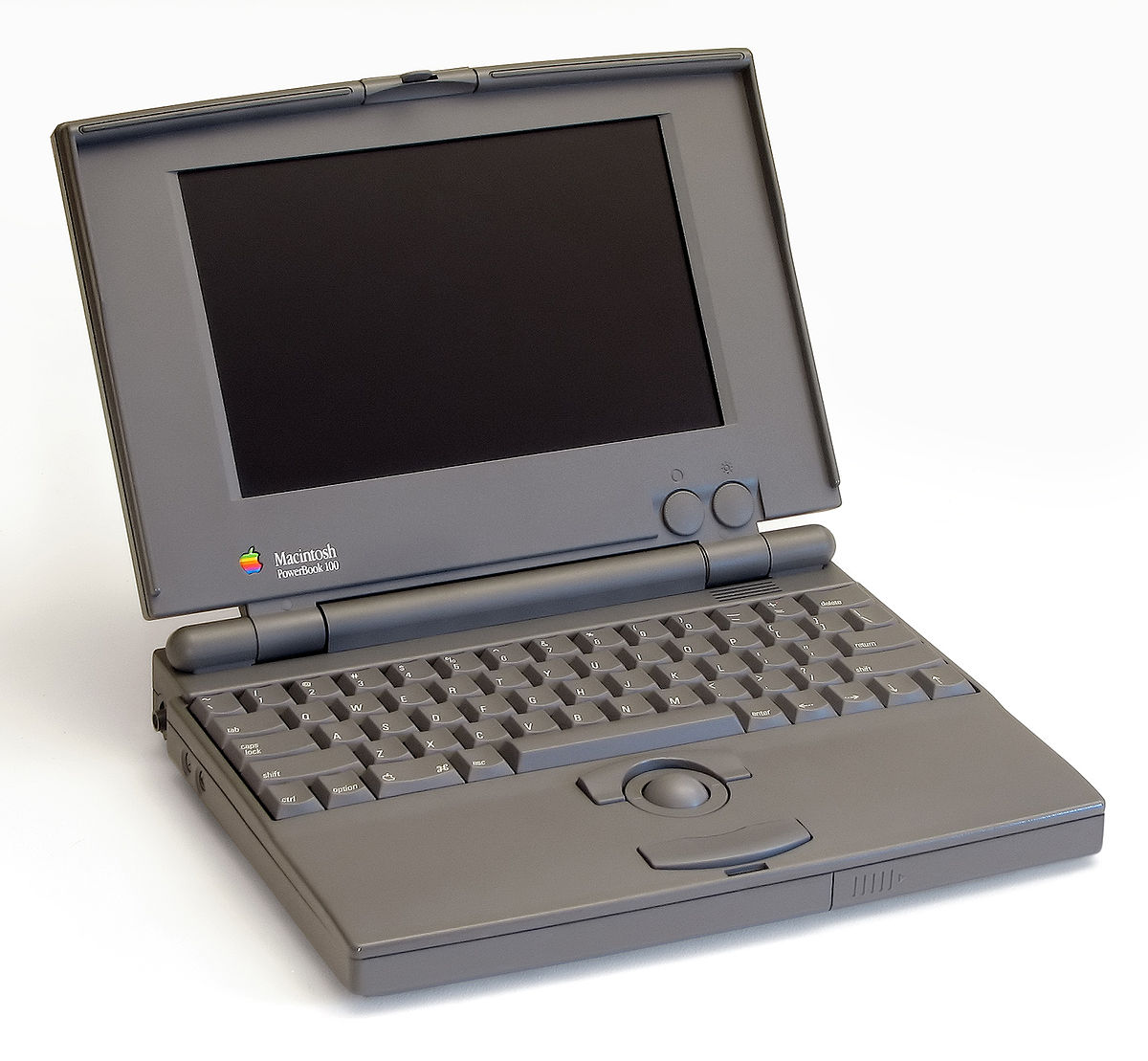I don’t know. I think I’ll take SATA and USB over SCSI any day of the week. Also, at least present day macOS is stable. I think mid 90s but faster would just mean you see system bomb errors even quicker.everything would be as it was in the mid 90s, but faster
You are using an out of date browser. It may not display this or other websites correctly.
You should upgrade or use an alternative browser.
You should upgrade or use an alternative browser.
Fantasy M88100 Macs
- Thread starter Snial
- Start date
CC_333
Well-known member
Well, sure. I didn't necessarily mean it literally, of course!I don’t know. I think I’ll take SATA and USB over SCSI any day of the week. Also, at least present day macOS is stable. I think mid 90s but faster would just mean you see system bomb errors even quicker.
We can still enjoy many of the technological improvements we've had in the years since, but I just wish that GUIs in general could've stayed more or less as they were (i.e., modern MacOS that still looks like Classic).
But most importantly, I wish we could have the simple, 90s internet. The modern internet is fine and good, but it's becoming too complicated, invasive, and increasingly divisive (I won't go into more detail because politics).
c
Snial
Well-known member
I think @joshc is also writing partly in jest. I think most of the software reliability issues in the 90s were due to:Well, sure. I didn't necessarily mean it literally, of course!
We can still enjoy many of the technological improvements we've had in the years since, but I just wish that GUIs in general could've stayed more or less as they were (i.e., modern MacOS that still looks like Classic).
But most importantly, I wish we could have the simple, 90s internet. The modern internet is fine and good, but it's becoming too complicated, invasive, and increasingly divisive (I won't go into more detail because politics).
- Cooperative multitasking instead of preemptive (obviously).
- Relatively poor software standards - software disciple has improved a lot.
- Just lots more work applied to old and new software squeezing out bugs.
- Proper protected OSs and applications (biggest classic Mac OS mistake, besides sticking flags in addresses <facepalm> was to run it in Supervisor mode, even the QL didn't do that - did the ST and Amiga? I guess the Amiga didn't).
Since FDDs & HDs by their very nature were serial devices, the dumb thing IMHO was to place the deserialisation close to the peripheral instead of close to the CPU.I don’t know. I think I’ll take SATA and USB over SCSI any day of the week.
Anyway, seems like ATA and SCSI kissed and made-up through SATA and SAS:
In what sense does SATA "talk" SCSI? How much is shared between SCSI and ATA?
This is nothing new to me at least, that SATA actually "talks" SCSI, hence why these SATA devices show up as SCSI devices in Linux. A related question has been asked before, e.g. Why do my SATA de...
Super-ironically, of course, parallel ZIP drives actually talk SCSI over the parallel port!!!
Even before that, ATAPI drives for PCs (CD and DVD-ROM, Zip, probably a few other things) used SCSI commands sent over an ATA physical transport. As often happens in the computer industry, "baroque but cheap" wins.Anyway, seems like ATA and SCSI kissed and made-up through SATA and SAS:
With respect to software reliability, proper protected OSes are 90% of the improvement, and improved tooling (Valgrind, Coverity, the Clang -checker builds, VTune, etc) is most of the rest. You could have a cooperative multitasking OS with memory protection and process separation and it'd be pretty much as reliable as modern OSes in daily use. The classic Mac OS suffered far more from memory overwrites and related crashes than from applications refusing to give up their time slices.
As far as M88K, it'd be cool if the ROMs from the original "RISC LC" ever showed up. That could definitely be supported in MAME.
Phipli
Well-known member
It's out there - the computer history museum interviewed... The developer with it on the table. I can't remember their nameAs far as M88K, it'd be cool if the ROMs from the original "RISC LC" ever showed up. That could definitely be supported in MAME.
Not sure if the developer has it or the museum.
Snial
Well-known member
Isn't the developer: Gary Davidian?It's out there - the computer history museum interviewed... The developer with it on the table. I can't remember their namesorry.
Not sure if the developer has it or the museum.
www.FastAndSmallSoftware.com
www.garydavidian.com
I think it's in part 2:
You'll see he gets out the LC just a few seconds on from where this clip starts.
Phipli
Well-known member
That's himIsn't the developer: Gary Davidian?
www.FastAndSmallSoftware.com
www.garydavidian.com
I think it's in part 2:

Snial
Well-known member
Cool, that's what I've just been listening to. I hadn't remembered it was called the RLC, but I listened to all of the videos on my walks last year - I found them fascinating - hence that's why I started this topic, because essentially it's the genesis of the PowerMac. It's interesting therefore that I chose R41, R51 and R61 as the product names for the fantasy 88K-based Macs. Though more recently I've been trying to think about what the name for the product family could have been. So, by the time Apple released the PowerPC Macs, it was fairly obvious they were going to be called PowerMacs and part of the clue for that is that the laptop range had been titled PowerBook since 1991 just after (I believe), the PowerPC development announcement.
So, in the alternative history, there's no PowerMacs, because Apple didn't choose PowerPC. That means there's also no PowerBooks. I went through a few possible product family names:
- TurboMac. PC compatibles were using this kind of prefix already.
- DynaMac. The ultimate objective of Macs was to create Alan Kay's mythical DynaBook and 'Dyna' might be a good name, because they would have a fairly dynamic performance: slower under emulation, but much faster running native and it sounds impressive. However, it also means they'd called the laptops DynaBooks which I think is too pretentious even for Apple.
- RiscMac. Too technical, also I wouldn't have it conflict with Acorn's RiscPC series even though that'd be a bit in the future.
- MotoMac. But the 68K ones are already Motorola-based and tying the name to a specific company wouldn't be Apple.
So, then I started wondering if Gary Davidian had the original source code for the RLC ROMs or if it was possible to see the RLC in action? He seems like a decent guy, what happens if we contact him?
OK, I've emailed him! I'll see what happens!
Last edited:
cheesestraws
Well-known member
PowerBooks
The name powerbook is not powerpc-related as far as i know
Phipli
Well-known member
I found them fascinating - hence that's why I started this topic, because essentially it's the genesis of the PowerMac.
The PowerPC Macintosh book : the inside story on the new RISC-based Macintosh : Somogyi, Stephan : Free Download, Borrow, and Streaming : Internet Archive
The PowerPC Macintosh Book 1994
archive.org
I've heard that Apple was superstitious of "III" after the fiasco with the Apple III. LC III allegedly got through on the basis that it was two words before the dreaded III instead of just one, but "Macintosh III" was specifically skipped on the way to "Quadra".They might have just gone with the Macintosh III?
Phipli
Well-known member
Ah, fair enough. Macintosh Quintra it is then.I've heard that Apple was superstitious of "III" after the fiasco with the Apple III. LC III allegedly got through on the basis that it was two words before the dreaded III instead of just one, but "Macintosh III" was specifically skipped on the way to "Quadra".
Snial
Well-known member
Possibly true, but the first PowerBooks appeared in October 1991, and the letter of intent for the PowerPC Alliance began in the summer of 1991, and formally cemented on October 2, 1991. The Book bit is easy to explain, because of the DynaBook concept, but it's hard (for me) to explain why Apple would call the range PowerBooks if they hadn't intended to keep the name in anticipation of PowerPC Macs (and importantly, PowerPC laptops).The name powerbook is not powerpc-related as far as i know

AIM alliance - Wikipedia

PowerBook 100 - Wikipedia
M88K Emulation Perfomance
Earlier in the thread I tried to imagine what the M88K emulation performance might be like. I came up with about 10 cycles minimum per emulated instruction, using the 2-word table approach actually used by the PowerPC emulator. Is this credible? To estimate this I looked up the SpecInt performance of M88100 computers (basically the AViiON systems by Data General); compared that with SpecInt for early PowerPC and scaled it against early PPC emulation performance.
| System/CPU | MHz | SpecInt92 | Ratio |
|---|---|---|---|
| DG 4100/88100 | 25 | 17.4 | 0.28 |
| IBM 250/MPC601 | 66 | 62.6 | 1 |
| HP 425t/68040 | 25 | 12.3 | 0.20 |
| Compaq DkPro/80487SX | 25 | 14.2 |
So, if a PowerMac at 66MHz was similar to a Mac Iici/Cache at 25MHz. Then from this LowEndMac link, such a Mac Iici was 4.3x faster than a Mac SE, then a 25MHz 88100 M88K Mac would possibly emulate a 68K at 1.2x the speed of a Mac SE, which essentially ran at 7.5MHz. Now we can calculate the number of M88K clock cycles, since the minimum instruction = 7.5/4 = 1.875 MIPs, so 25MHz/1.875 = about 13 cycles per minimal instruction. It's not really possible to use the full 0.175MIPS/MHz (vs 0.25MIPS/MHz), because my emulator draft doesn't handle more complex instructions (and addressing modes: loads and stores increase emulated performance, decoding decreases it, multiplies and divides would be faster [but are rare], FPU much faster, Barrel shifter would emulate at 10c for all immediate shifts, but 14c on average for a 68000 [so immediate shifts would emulate on average like a 35MHz 68000 !!!] etc).
One final note: I've included the 68040's and 80487SX SpecInts on the bottom line. The 68040 aims for RISC-like performance, and the 88100 is only 40% faster at 25MHz (like a 35MHz '040), but we can see that it's already losing out to Intel. Given the emulation hit and the relative cost of an 88100 chipset, could an M88K Mac even make sense? - Only for specialised applications IMHO, but that was the assumption at the beginning.
Phipli
Well-known member
Don't forget that the SE wasted CPU time while the video / audio was accessing RAM. So the SE doesn't get the performance of the full number of clock cycles.then a 25MHz 88100 M88K Mac would possibly emulate a 68K at 1.2x the speed of a Mac SE, which essentially ran at 7.5MHz.
The 88k Mac wouldn't suffer from that because they'd moved on from that sort of architecture. (Yes, the PowerPCs used RAM for video, but it used some sort of DMA to improve efficiency - yes it used CPU cycles to move data, but was able to do more while the video was using RAM)
cheesestraws
Well-known member
Possibly true, but the first PowerBooks appeared in October 1991, and the letter of intent for the PowerPC Alliance began in the summer of 1991, and formally cemented on October 2, 1991. The Book bit is easy to explain, because of the DynaBook concept, but it's hard (for me) to explain why Apple would call the range PowerBooks if they hadn't intended to keep the name in anticipation of PowerPC Macs (and importantly, PowerPC laptops).
This is conspiracy-theory level thinking, and assumes a competence in Apple's internal communications that there's no evidence they have ever had. They obviously were totally happy to rename things when PPC hit in the desktop space, why wouldn't they have been in the laptop space? Coincidence of dates is not, in itself, evidence.
Snial
Well-known member
Well, I have to start somewhere ;-) .This is conspiracy-theory level thinking
Also true.and assumes a competence in Apple's internal communications that there's no evidence they have ever had. They obviously were totally happy to rename things when PPC hit in the desktop space, why wouldn't they have been in the laptop space? Coincidence of dates is not, in itself, evidence.
I thought they'd basically eliminated the cost for that with the Mac SE vs the Mac Plus, but I could easily be falling victim to Apple Marketing here!Don't forget that the SE wasted CPU time while the video / audio was accessing RAM. So the SE doesn't get the performance of the full number of clock cycles.
Interesting and encouraging.The 88k Mac wouldn't suffer from that because they'd moved on from that sort of architecture. (Yes, the PowerPCs used RAM for video, but it used some sort of DMA to improve efficiency - yes it used CPU cycles to move data, but was able to do more while the video was using RAM)
Phipli
Well-known member
I was trying to find the figures but failing - basically they doubled the size of the shift register so that it reads two words instead of one on the older design. Instead of 50% access during a scan line you get two CPU accesses for every one video... I think it was. Then you have to account for vertical and horizontal blank that improves the ratio.I thought they'd basically eliminated the cost for that with the Mac SE vs the Mac Plus, but I could easily be falling victim to Apple Marketing here!
But yes, better than the plus, but still not that good really. A lot of lost time.
If you're really interested I could try to find last time it was discussed, or probably calculate it again. Thankfully the lack of cache makes it a simple calculation!
Snial
Well-known member
It is interesting! I thought it might be that they used faster RAM on the SE, but cleverer hardware is less unimpressive ;-) . So, were SE ROM fetches also stalled for video? Using alternate phases for video access was quite common on 6502 computers. I guess the calculation is of the order: 60.15Hz x 512 x 342 / 16 x 4 = number of cycles used for video = 2.6M. So, out of 7.5MHz, that's: 35%, ouch, but I'm not considering the proportion of internal CPU cycles. Were they inspired by ZX81 video or something ;-) ?I was trying to find the figures but failing - basically they doubled the size of the shift register so that it reads two words instead of one on the older design. Instead of 50% access during a scan line you get two CPU accesses for every one video... I think it was. Then you have to account for vertical and horizontal blank that improves the ratio.
But yes, better than the plus, but still not that good really. A lot of lost time.
If you're really interested I could try to find last time it was discussed, or probably calculate it again. Thankfully the lack of cache makes it a simple calculation!
Phipli
Well-known member
I.... Think it could possibly still read ROM? I think I read that. But I haven't seen it while reading just now. I'll let you know what I find.It is interesting! I thought it might be that they used faster RAM on the SE, but cleverer hardware is less unimpressive ;-) . So, were SE ROM fetches also stalled for video? Using alternate phases for video access was quite common on 6502 computers. I guess the calculation is of the order: 60.15Hz x 512 x 342 / 16 x 4 = number of cycles used for video = 2.6M. So, out of 7.5MHz, that's: 35%, ouch, but I'm not considering the proportion of internal CPU cycles. Were they inspired by ZX81 video or something ;-) ?
Do you know how long it would take to read two 16bit consecutive words from RAM?
Similar threads
- Replies
- 28
- Views
- 3K
- Replies
- 60
- Views
- 8K
- Replies
- 21
- Views
- 7K
